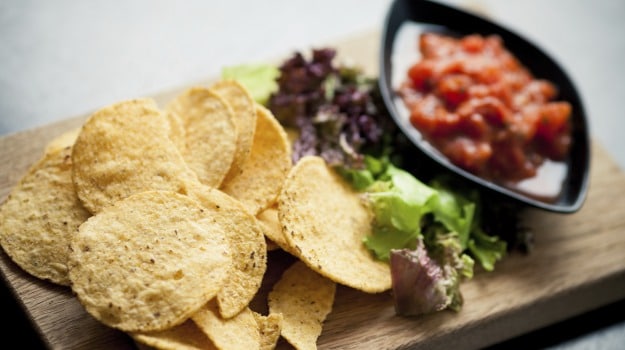In an era of digital denizens, food aesthetics rule the roost. You want to moon over everything in sight, snap and share. Plate presentation is where the buck stops. But walk away from the fad and think about what you like most about food? We’re all in favour of taste and aroma, but when I hear sizzlers hissing off the grill, the crackle of curry leaves from the pan or simply the sound of the first bite into a crisp apple, I might as well be in heaven. You’ll have to agree, it’s the popping of popcorns that makes us love them so much more. And well, science has proven that the way food sounds affects how good it tastes and how much we enjoy it. In a new report published in the journal Flavour, researchers at Oxford University reviewed the relationship that sound and flavor perception share, and concluded that what foods sound like is incredibly important to the experience of eating. Making sense of your senses
Flavour is a multi-sensory perception. When 140 scientists working in the field of food research were questioned they rated taste, smell and temperature as most important to assess the flavour, followed by texture, appearance and sound. “Our brains are all the time trying to pick up correlations in the environment,” says Professor of Experimental Psychology, Charles Spence. He calls sound the “forgotten flavour sense.” In 2007, researchers from the University of Leeds examined just how important the crispness of the bacon, especially the sound of the crunch, is to the perfect BLT sandwich. Dr. Graham Clayton, the lead researcher concluded, “We often think it’s the taste and smell of bacon that consumers find most attractive. But our research proves that texture and the crunching sound is just – if not more – important.’’ But why is the way food sounds important to us? Remember that our first experience of a food plays an important role in creating subsequent memory or the recall value which is often based on the aroma or the sound. What we hear can help us identify different textures - how crispy, crunchy, crackly or fizzy something may be. These words are flattering when it comes to food. Even soft foods make sounds when they are chewed, bitten or sliced. Textures like creamy, sticky and chewy are linked with the sense of sound that contributes to the mouth feel and taste.. Sound may influence our judgment of food texture more effectively than taste. We also tend to consider that cracking sound as an indicator of freshness and quality. Think about it. If the first chip that you tuck into cracks crisply, you know you’re hooked. Sound is an important factor that determines what draws us to certain foods. This explains why most food advertisements feature exaggerated sounds, everything from the crunch of a chip to the snap of cookie.
Few years ago, Unilever asked their consumers what they would like to change about the chocolate-covered Magnum ice cream. Most of them complained that the chocolate coating was so crispy that it fell off easily. They altered the product, but the distinctive cracking sound of the chocolate coating was lost. The new product was launched and the consumers were left disappointed. They missed the solid cracking of the chocolate casing and that became the signature feature of these ice cream bars. It’s safe to say that, people use sounds to assess how tasty food is, even if they don’t realise it.
The big noise
Changing the sounds of food can influence a person’s perception. This has been proved by Spence in one of his previous studies where people gave fizzy drinks higher ratings when the sound of the bubbles was louder and more frequent. When you hear the rush of fizziness, you know it’s worth a glug. (Pause) Snap back.
The current study indicates that a growing number of food companies, chefs and restaurants are paying more attention to the sounds that their foods make when eaten. Kellogg’s, for instance, believes that the crunchiness of the grain is a key driver of the success of their cornflakes, says the study. We tend to like crispy foods better when they are noisier and soft foods with hushed undertones.
(How Sound Affects the Taste of our Food) Modernist chefs are beginning to understand how our senses interact to enhance flavours through molecular gastronomy and blind tasting sessions. “We associate sound with memories and the same goes for food. The popping of champagne and when it fizzes out evokes a certain kind of expectation and perception regarding the flavour. Through the sounds, your brain senses the flavour even before you try it. And when you hear the same sound, you perceive the flavour on the basis of it,” says Chef Abhijeet Saha, an expert in Modern European and Regional Indian cuisines. “We marry multiple textures. The crackling of parmesan or the crispy crusts of filo pastry brings the flavours alive,” he adds.
Accoring to Chef Saurabh Udinia from Farzi Cafe, known for creating gastronomic illusions,"Every dish has at least six to ten finished elements, which makes it different and unique. For instance, I serve sarson ka saag galouti with chaas spheres. This dish has chaas bubbles, cocktail onions, white butter, micro greens and masala popcorns. It is a medley of textures and hence, have different sounds. The burst of the sphere, crispy popcorns, crunch of the onion, the smoothness of the galouti and butter - every element has its own sound which breaks the monotony and leaves you with a better experience and taste." It may be in its infancy, but some research shows that the sound of food can help people revive the sense of taste. “In the future, my guess is that various technologies, some of which will be embedded in digital artefacts, will increasingly come to augment the natural sounds of our foods at the dining table,” Spence said. Listen up! Because what snaps, crackles and pops might open up your palate while you’re at it. With inputs from Journal Flavour








